

An encyclopedia of Middle-earth and Numenor

|
|
|
|
|
|
|
|
|
|
|
|
|
|
| |
|
 |

An encyclopedia of Middle-earth and Numenor |
 |
Balrogs |
Gandalf
vs. the Balrog
in the New Line film |
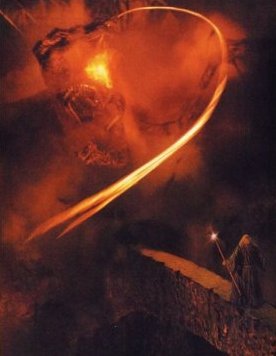 Demons
of shadow and flame. Balrogs were creatures of great power and terror.
Their fundamental form appeared to be that of a man of great stature, but
they were cloaked in shifting shadows and they had fiery cores.
Demons
of shadow and flame. Balrogs were creatures of great power and terror.
Their fundamental form appeared to be that of a man of great stature, but
they were cloaked in shifting shadows and they had fiery cores.
Balrogs had burning yellow eyes and streaming manes that kindled with fire. Their arms were long and powerful, and they may or may not have had wings (see below). The Balrogs' chief weapons were whips with flaming thongs.
Balrogs belonged to the order of the Maiar - the servants of the Valar. The Balrogs were originally spirits of fire that were corrupted by Morgoth in the beginning. The number of Balrogs that existed is uncertain. In some stories there were entire armies of Balrogs, but a late note suggests that there were only between three and seven Balrogs ever in existence. (HoME X, p. 79-80)
The Balrogs dwelled in Morgoth's strongholds of Utumno and Angband in Middle-earth. When those fortresses were destroyed by the Valar in the Battle of the Powers, some Balrogs hid in the caverns below and they awaited Morgoth's return from captivity.
In 1495 of the Years of the Trees, Morgoth stole the Silmarils and fled to Middle-earth. Ungoliant - an evil being in spider form - tried to take the Silmarils, but Balrogs lurking in Angband heard Morgoth's cry and came to his aid. They freed Morgoth from Ungoliant's webs with their flaming whips and Ungoliant fled from them in fear.
In 1497, Feanor marched to Angband to retrieve the Silmarils, and Balrogs came forth and surrounded him. Feanor withstood many lashes from their fiery whips until at last he was mortally wounded by Gothmog, Lord of Balrogs. Afterwards, Morgoth said he would negotiate with the Elves, but he sent Balrogs with his emissaries and Feanor's son Maedhros was taken captive.
During the Battle of Sudden Flame in the year 455 of the First Age, Glaurung the Dragon led a host of Balrogs and Orcs from Angband. Morgoth's forces dealt the Elves and Men a significant defeat and drove far into Beleriand before they were turned back by Thingol.
At the Battle of Unnumbered Tears in 472, Gothmog, as high-captain of Angband, led a force to drive apart the armies of Fingon and Turgon. While another Balrog trapped Fingon with its fiery whip, Gothmog cleaved Fingon's helmet with his axe and slew him. The Balrogs then beat Fingon's body into the ground with their maces.
Turgon's army retreated to Gondolin through the Pass of Sirion covered by Hurin and the Men of Dor-lomin. In the Fen of Serech, all the Men were slain except Hurin, who was captured by Gothmog and brought to Angband where he was imprisoned for 28 years.
Gothmog led his Balrogs in the assault on Gondolin in 510. In the Square of the King, Gothmog attacked Tuor but the Elf-lord Ecthelion intervened. Gothmog wounded Ecthelion's sword-arm and Ecthelion drove the spike on his helmet into Gothmog's chest. They fell together into the great fountain and sank to the bottom and died.
Another Balrog tried to prevent the escape of Tuor, Idril, and Earendil in the pass called the Eagles' Cleft. Glorfindel engaged the Balrog in battle to allow the others to escape. They fought on the precipice and both fell into the abyss to their deaths.
When the Host of the Valar vanquished Morgoth in the War of Wrath at the end of the First Age, most of the Balrogs were destroyed, but a few fled into deep underground caverns. The fate of only one of these is known: It went to the Misty Mountains and hid at the roots of the Redhorn, where it lurked for over 6,000 years.
In 1980 of the Third Age, the Dwarves of Khazad-dum were delving under the Redhorn for mithril when they encountered the Balrog. The Balrog may have been roused by their mining or it may already have awakened in response to the growing power of Sauron. King Durin VI was slain by the Balrog, and the next year it killed Durin's son Nain I. The Dwarves abandoned Khazad-dum and it became known as Moria, the Black Chasm, and Orcs and other evil creatures came to dwell there.
In 2989, Balin came to Moria to try to reestablish a Dwarf colony there, and the Balrog stirred once more. The colony was destroyed just a few years later in 2994.
The Fellowship of the Ring entered Moria on January 13, 3019, and the Balrog became aware of their presence. On January 15, the Balrog entered the Chamber of Mazarbul after the Fellowship had left and it perceived Gandalf beyond the door. Like the Balrog, Gandalf too was of the order of Maiar. Gandalf placed a shutting-spell on the door, but the Balrog cast a counter-spell and was nearly able to open the door, and then Gandalf spoke a word of Command. In the struggle between the two, the door shattered and the roof of the chamber collapsed.
The Balrog escaped and pursued the Fellowship to the Bridge of Khazad-dum. Gandalf remained on the bridge and denied the Balrog passage. The Balrog wielded a whip of many thongs and a flaming sword. Gandalf used Glamdring to shatter the blade of the Balrog's sword into molten fragments. He then struck the bridge with his staff and the stone cracked under the Balrog's feet. The Balrog fell into the abyss with a terrible cry and it lashed its whip and caught Gandalf around the knees, dragging the Wizard in after it.
The Balrog and Gandalf fell together for a long time, and Gandalf was burned by the creature's fire. They landed in a subterranean lake at the root of the mountains. The Balrog's fire was quenched and it became slimy, but it remained strong and it continued to battle with Gandalf. Then the Balrog fled through the tunnels to the Endless Stair and climbed to the peak of the Silvertine with Gandalf in pursuit.
The Balrog burst into flame again, and it fought Gandalf in the Battle of the Peak from January 23 to 25. At last Gandalf threw the Balrog down from the peak and it shattered the mountain-side and died. Gandalf died as well, but he was returned to life as Gandalf the White.
There are no further reports of Balrogs in the history of Middle-earth, so the Balrog of Moria may well have been the last of its kind.
Do
Balrogs have wings?
This is one of the most debated
issues among Tolkien fans. There is no definitive answer. The question
centers mainly on these sentences describing the Balrog:
The Balrog ... halted again, facing him, and the shadow about it reached out like two vast wings ... It stepped forward slowly on to the bridge, and suddenly it drew itself up to a great height, and its wings were spread from wall to wall ...This passage can be read two ways. Those who believe that Balrogs have wings interpret this as saying that the Balrog had physical wings on its body that it spread from wall to wall. Those on the opposing side say that the wings that were spread out were not real wings, but were instead the shadow around the Balrog, which is described as reaching out like wings.
The Fellowship of the Ring: "The Bridge of Khazad-dum," p. 344-45
There are a few other ambiguous passages that are relevant to the debate:
"Thus they roused from sleep a thing of terror that, flying from Thangorodrim, had lain hidden ..."Here flying may be used in the sense of traveling through the air, or it may mean fleeing.
Appendix A: "Durin's Folk," p. 353
"Swiftly they [the Balrogs] arose, and they passed with winged speed over Hithlum ..."The phrase "winged speed" may be used literally or metaphorically.
The History of Middle-earth, vol. X, Morgoth's Ring: "Of the Thieves' Quarrel," p. 297
"Too much it reminded me of the shadow in Moria - the shadow of the Balrog."In this quote, Gimli is reacting to encountering a Winged Nazgul for the first time. Gimli may be referring to the physical shape of the creature, or the shape of its shadow, or even simply the feeling of terror it evoked.
The Fellowship of the Ring: "The Great River," p. 404
Another issue cited by those who think Balrogs do not have wings it that Balrogs do not fly in several instances when it would benefit them to do so. For example, when Glorfindel battled the Balrog at Gondolin, the Balrog fell to its death and did not save itself by flying as one might expect if it had wings. The Balrog that Gandalf battled also fell into an abyss and was later cast down from the peak of the Silvertine.
Those who believe that Balrogs have wings explain this lack of flying in a variety of ways. Some say that Balrogs could not use their wings to fly. Others say that in these particular circumstances the Balrogs were unable to fly, either because of the trajectory of the fall, the narrowness of the space, or the injuries sustained in combat.
In the end, there is nothing in Tolkien's writings that definitively states whether he intended for Balrogs to have wings or not. So - unless someone encounters a Balrog in the modern world and lives to tell the tale - the question of whether Balrogs have wings remains open to each reader's interpretation.
Names &
Etymology:
The name Balrog means "Demon
of Might" in Sindarin from bal meaning "power" and rog meaning
"demon."
Also called Valarauko (singular) and Valaraukar (plural) in Quenya. Valarauko also means "Demon of Might" from val meaning "power" and rauko meaning "demon."
The Balrog of Moria was called Durin's Bane because it killed King Durin VI. A bane is a cause of death, ruin or harm. Legolas called it an elf-bane because in the First Age a number of Elves were slain by Balrogs.
Gandalf called the Balrog Flame of Udun. Udun essentially means "Hell." It was another name for Morgoth's terrible underground stronghold Utumno where the Balrogs once dwelled. (Note that there was also a valley in Mordor named Udun, which probably was named for Utumno, but which had no connection with Balrogs.)
Aragorn referred to the Balrog as the Terror.
Gothmog is composed of the words goth meaning "dread" and baug meaning "tyrannous, cruel, oppressive."
Sources:
The Fellowship
of the Ring: "The Bridge of Khazad-dum," p. 340-41, 344-45; "The Mirror
of Galadriel," p. 371
The Two
Towers: "The White Rider," p. 105-106
The Return
of the King: Index entry p. 436 (Udun = Hell)
Appendix
A of The Lord of the Rings: "Durin's Folk," p. 353, 356
The Silmarillion:
"Valaquenta - Of the Enemies," p. 31; "Of the Coming of the Elves and the
Captivity of Melkor," p. 47, 51; "Of the Flight of the Noldor," p. 81;
"Of the Return of the Noldor," p. 107-108; "Of the Ruin of Beleriand and
the Fall of Fingolfin," p. 151-52; "Of the Fifth Battle," p. 193-95; "Of
Tuor and the Fall of Gondolin," p. 242-43; "Of the Voyage of Earendil and
the War of Wrath," p. 251; "Appendix - Elements in Quenya and Sindarin
Names," entries for rauko and val
The History
of Middle-earth, vol. II, The Book of Lost Tales Part Two: ""The Tale
of Tinuviel," p. 67; The Fall of Gondolin," p. 176, 179, 183-84, 212-13,
215-16
The History
of Middle-earth, vol. V, The Lost Road and Other Writings: "The Etymologies,"
entries for GOS, GOTH and MBAW
The History
of Middle-earth, vol. VII, The Treason of Isengard: "The Mines of Moria
(2): The Bridge," p. 197-98
The History
of Middle-earth, vol. X, Morgoth's Ring: "The Annals of Aman," p. 75,
79-80
The Letters
of J.R.R. Tolkien: Letter #144
The Lord
of the Rings: A Reader's Companion by Wayne G. Hammond and Christina
Scull: "The Bridge of Khazad-dum," p. 295
Barrow-wights |
Barrow-wight
by John Howe
|
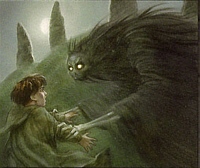 Evil
spirits inhabiting the burial mounds of the Barrow-downs
in Eriador. Originally the barrows were the
resting places of the Dunedain and their ancestors, but the Barrow-downs
were abandoned when the Dunedain were stricken by the Great
Plague in 1636 of the Third Age. The Witch-king
then sent evil spirits from
Angmar and
Rhudaur to occupy the barrows. The Barrow-downs became a place of fear
and even Hobbits had heard of their sinister reputation.
Evil
spirits inhabiting the burial mounds of the Barrow-downs
in Eriador. Originally the barrows were the
resting places of the Dunedain and their ancestors, but the Barrow-downs
were abandoned when the Dunedain were stricken by the Great
Plague in 1636 of the Third Age. The Witch-king
then sent evil spirits from
Angmar and
Rhudaur to occupy the barrows. The Barrow-downs became a place of fear
and even Hobbits had heard of their sinister reputation.
On September 23, 3018, the Witch-king came to the Barrow-downs to rouse Barrow-wights to watch for trespassers on their land. Frodo Baggins and his companions entered the Barrow-downs on September 28 after leaving the house of Tom Bombadil. Tom advised the Hobbits to pass the barrows on the west side. They hoped to make it across the downs to the Great East Road by nightfall, but they fell asleep while resting on a hill and a fog rolled in that caused them to become disoriented.
Frodo realized he had been separated from his companions and tried to find them, but he heard an eerie voice calling to him and was confronted by a tall dark figure in the fog. He lost consciousness and woke to find himself inside a barrow. The barrow may once have been the tomb of the last prince of Cardolan, who was killed in battle against the forces of Angmar in 1409, but it had become the home of a Barrow-wight.
Frodo saw Merry, Pippin and Sam lying on the ground with a sword across their necks. They had been dressed in white robes and adorned with gold and jewels. A green light filled the barrow and Frodo heard a voice chanting.
Cold be hand and heart and bone,A hand appeared, creeping toward the hilt of the sword that lay on the Hobbits' necks. Frodo felt an overwhelming temptation to put on the Ring, but he resisted it and instead used a sword to cut off the hand at the wrist. He then called for Tom Bombadil, who came and released the Hobbits from the barrow. He sang a song to banish the Barrow-wight, and it fled with a shriek. Tom gave the Hobbits swords from the barrow that had been used to fight the Witch-king long ago. He then spread out the gold and treasures from the barrow on the grass so that the barrow's spell was broken and no Wight would return to it.
and cold be sleep under stone:
never more to wake on stony bed,
never, till the Sun fails and the Moon is dead.
In the black wind the stars shall die,
and still on gold here let them lie,
till the dark lord lifts his hand
over dead sea and withered land.
The Fellowship of the Ring: "Fog on the Barrow-downs," p. 152
Sources:
The Fellowship
of the Ring: "In the House of Tom Bombadil," p. 145; "Fog on the Barrow-downs,"
passim
Appendix
A of The Lord of the Rings: "The North-kingdom and the Dunedain," p.
320-21
Unfinished
Tales: "The Hunt for the Ring," p. 348
Ancalagon the Black first appeared during the War of Wrath at the end of the First Age. Morgoth was losing the war and he released the winged Dragons from Angband in a final attempt to defeat the Host of the Valar.
Winged Dragons had never been seen before and at first the host of the Valar retreated. Then Earendil came in his flying ship Vingilot bearing one of the Silmarils, and with him came Thorondor, King of the Eagles, leading an army of great birds. A fierce battle was fought in the air for a full day and night.
Just before dawn, Earendil slew Ancalagon. Ancalagon's body fell from the sky and destroyed the towers of Thangordrim above Angband. Most of the other Dragons were killed and the Host of the Valar captured Angband. Morgoth was banished from the world and was cast into the Void.
Names &
Etymology:
The name Ancalagon is composed
of the Sindarin words anc meaning "jaw, row of teeth" and alag
meaning
"rushing." The name is translated as "Biting Storm."
Sources:
The Fellowship
of the Ring: "The Shadow of the Past," p. 70
The Silmarillion:
"Of the Voyage of Earendil and the War of Wrath," p. 252; "Appendix - Elements
in Quenya and Sindarin Names," entries for alqua and anca
The History
of Middle-earth, vol. V, The Lost Road and Other Writings: "The Etymologies,"
entries for ALAK and NAK
Glaurung |
Glaurung
by John Howe
|
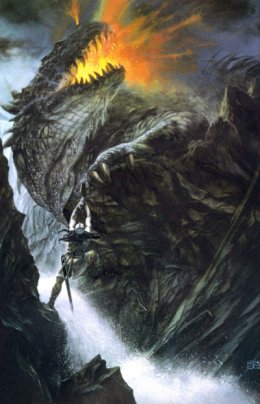 First
of the Dragons of Morgoth. Glaurung was a fire-breathing Dragon. He and
his descendants were known as the Uruloki, or Fire-drakes. Glaurung's body
was covered with hard armor except for his underbelly which was soft and
vulnerable.
First
of the Dragons of Morgoth. Glaurung was a fire-breathing Dragon. He and
his descendants were known as the Uruloki, or Fire-drakes. Glaurung's body
was covered with hard armor except for his underbelly which was soft and
vulnerable.
Glaurung did not have wings and could not fly. He crawled or slithered on his belly like a worm. He was swift and lithe though he was of great size. Glaurung had sharper eyesight than the Eagles or Elves, and his hearing was keen as well. His body gave off heat and a terrible stench.
Glaurung's strength came from the evil spirit within him which also enabled him to speak. Those who looked into his eyes fell under his spell and he was able to manipulate them. Glaurung had a strong will and he was cunning and malicious.
Glaurung first appeared in 260 of the First Age. At that time the Siege of Angband was in effect and Morgoth's stronghold was under watch by the Elves. One night, Glaurung emerged from the gates of his own accord without orders from Morgoth. The Elves did not know what kind of creature he was and they fled. Glaurung began to defile the green fields of Ard-galen.
Fingon led a company of mounted archers to confront Glaurung. The Dragon was only half-grown and his armor was not fully formed, and the volley of arrows forced him to retreat back to Angband. Morgoth was angry that Glaurung had revealed himself to the Elves before he was ready.
Soon afterwards, the Dwarf-craftsman Telchar made the Dragon-helm for Azaghal, Lord of Belegost. The Dragon-helm had image of Glaurung on its crest and it had a visor that shielded the wearer from the Dragon's fire and enthralling gaze.
Morgoth broke the Siege of Angband in the Battle of Sudden Flame in 455. Rivers of fire ran down onto Ard-galen, and Glaurung - now fully grown - led forth an army of Balrogs and Orcs. Many Elves and Men were slain and the rest scattered and retreated to their strongholds. Glaurung passed through Maglor's Gap leaving a trail of destruction in his wake and enabling Orcs to enter East Beleriand.
At the Battle of Unnumbered Tears in 472, Glaurung led a force of wolves and wolfriders, Balrogs, and Dragons. Glaurung drove apart the armies of Maedhros and Fingon, and many Elves and Men perished in the heat of his scorching fire.
The Dwarves of Belegost led by Azaghal made a last stand against Glaurung, surrounding the Dragon and assailing his armor with their axes. Glaurung was enraged and slew Azaghal, but with his last stroke Azaghal stabbed Glaurung in his soft belly with a knife. Glaurung retreated from the battlefield but Morgoth's forces nevertheless won the battle. Glaurung eventually recovered from his wound.
In the autumn of 495, Glaurung came down through the Pass of Sirion with a great army to attack the stronghold of Nargothrond. He defiled Eithel Ivrin - the source of the Narog - and he burned the Guarded Plain. The Elves of Nargothrond were defeated by Glaurung's army in the Battle of Tumhalad and Orodreth, Lord of Nargothrond, was slain. Glaurung blasted through the Doors of Felagund and entered Nargothrond.
Glaurung confronted Turin, a Man whose family had been cursed by Morgoth. According to one story, Turin was wearing the Dragon-helm that had belonged to Azaghal, but he lifted the visor when Glaurung taunted him. (UT, p. 155) Turin fell under Glaurung's spell and he was unable to move even when Orcs carried away Orodreth's daughter Finduilas.
Glaurung lied to Turin, claiming that his mother Morwen and sister Nienor were enslaved in Dor-lomin. Glaurung then pretended to spare Turin's life so he could seek Morwen and Nienor and warned that if he delayed to go after Finduilas he would never see his mother and sister again. In so doing, Glaurung set in motion a chain of events that sealed the doom of Turin and his kin as Morgoth had intended. Turin soon learned he had been deceived: Morwen and Nienor had left Dor-lomin, and Finduilas was killed by her captors while Turin was sidetracked.
Glaurung broke the bridge into Nargothrond and burned the land around the entrance. He drove away his Orcs and claimed the empty halls for himself, gathering all the treasures into a hoard to rest upon.
Meanwhile, Morwen and Nienor learned that Turin had been at Nargothrond and set out to find him. Glaurung was aware of their approach and he emerged from his lair. As he crossed the Narog, a disorienting mist arose from the waters. Nienor became separated from her companions in the fog.
Glaurung climbed the slopes of Amon Ethir and laid his head on the hilltop. When Nienor reached the summit she found herself looking into the Dragon's eyes. Glaurung's will overcame hers and he placed a spell of forgetfulness on her so that she could not even remember her name. When she later encountered Turin she did not know him for her brother and he did not recognize her either since he had left home before she was born. Turin called her Niniel and they fell in love and were married.
After casting the spell, Glaurung's fires were temporarily quenched and he appeared ash-grey but he soon regained his full strength. He gathered an army of Orcs once more and he ruled as a Dragon-king in Nargothrond.
In 498, Glaurung sent Orcs to the Forest of Brethil where a band of Men opposed to Morgoth dwelled. Turin and Nienor Niniel lived there too, though it is not clear if Glaurung knew this initially. Turin led a company to defeat the Orcs and word reached Glaurung in Nargothrond.
In the spring of 499, Glaurung left Nargothrond to seek Turin. He scorched the earth as he approached the Forest of Brethil near the beginning of summer. The Dragon intended to cross the River Teiglin over a narrow ravine called the Deer's Leap. He may have avoided the Crossings of Teiglin because the tomb of Finduilas, Haudh-en-Elleth, was nearby.
Glaurung slept on the west side of the Deer's Leap and awoke in the night to begin his assault on the Forest of Brethil. He heaved the front part of his body across the ravine and started using his forelegs to pull the rest over. But Turin had anticipated that Glaurung would cross the river this way and he was waiting in the ravine below. He stabbed Glaurung in the soft underbelly with his sword Gurthang.
Glaurung screamed and cast himself onto the eastern side of the ravine. Turin followed to retrieve Gurthang but when he pulled the sword from the Dragon's belly his hand was burned by black venomous blood. Glaurung opened his eyes and gave a look of malice and Turin swooned.
Nienor Niniel had followed Turin. With his final breath, Glaurung told her that her husband was in fact her brother. When Glaurung died, Nienor remembered everything. She killed herself and her unborn child by jumping off the Deer's Leap into the River Teiglin. Turin awoke and learned the truth and he committed suicide by falling on his sword.
Glaurung's carcass was burned where he lay and nothing grew there again. His descendants continued to serve Morgoth and many took part in the destruction of Gondolin in 510.
Names &
Etymology:
The name Glaurung contains
the Sindarin word glaur meaning "golden light" and the element ung
meaning "gloom." He was called Glaurung the Golden. His name may
refer to the fires that burned within him; when they were quenched, he
was described as "ashen-grey" (UT, p. 119).
Glaurung was known as Father of Dragons because he was the first of his kind. Also called the Great Worm, the Worm of Morgoth, the Great Worm of Angband, and the Gold-Worm of Angband.
Sources:
The Silmarillion:
"Of the Return of the Noldor," p. 116-17; "Of the Ruin of Beleriand, "
p. 151-53; "Of the Fifth Battle," p. 192-93; "Of Turin Turambar," p. 212-26;
"Of the Ruin of Doriath," p. 229-30; "Of Tuor and the Fall of Gondolin,"
p. 239, 243
Unfinished
Tales: "Narn I Hin Hurin," p. 75, 107, 112, 117-20, 124-45, 149 note
25, 150 note 27, 154-55
The Children
of Hurin: Introduction, p. 26-27; "The Battle of Unnumbered Tears,"
p. 56; "The Departure of Turin," p. 78-79; "The Fall of Nargothrond," p.
176-81; "The Return of Turin to Dor-lomin," p. 188; "The Journey of Morwen
and Nienor," p. 198, 205-11; "The Coming of Glaurung," passim; "The Death
of Glaurung," passim; "The Death of Turin," passim
The History
of Middle-earth, vol. V, The Lost Road and Other Writings: "The Etymologies,"
entries for GLAW(R), LAWAR, and UNG
The History
of Middle-earth, vol. XI, The War of the Jewels: "The Grey Annals,"
p. 46, 52, 74-75, 85-88, 90, 93-94, 96-102, 143, 150
Fram took Scatha's hoard, but the Dwarves disputed his claim. Fram sent a necklace made from Scatha's teeth to the Dwarves, saying: "Jewels such as these you will not match in your treasuries, for they are hard to come by." (LotR, App. A, p. 346) The Dwarves were greatly insulted and they slew Fram.
When Eorl the Young led his people south to settle in Rohan, he brought with him a silver horn from Scatha's hoard. The Horn of the Mark was later given to Merry Brandybuck by Eowyn in recognition of his service to Rohan during the War of the Ring.
Names &
Etymology:
The name Scatha is from the
Old English meaning "injurer, enemy, robber."
Sources:
The Return
of the King: "Many Partings," p. 256
Appendix
A of The Lord of the Rings: "The House of Eorl," p. 345-46
"Nomenclature
of The Lord of the Rings," entry for Scatha
Smaug |
Smaug
by J.R.R. Tolkien
|
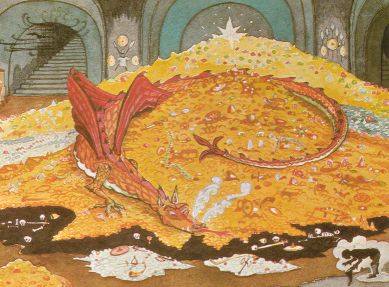 Dragon
who captured the Lonely Mountain. Smaug
was the greatest Dragon in the latter part of the Third Age. He was intelligent
and cunning and was able to speak the Common Speech. With his gaze he could
put people under a dragon-spell and compel them to do his bidding.
Dragon
who captured the Lonely Mountain. Smaug
was the greatest Dragon in the latter part of the Third Age. He was intelligent
and cunning and was able to speak the Common Speech. With his gaze he could
put people under a dragon-spell and compel them to do his bidding.
Smaug was a Fire-drake, or fire-breathing Dragon. He had sharp claws and teeth, a long tail, and great wings that could be folded when at rest. Smaug was red-golden in color and was covered with hard scales. His underbelly was pale and was encrusted with gems, but unbeknownst to Smaug there was a bare patch in the hollow of his left breast.
Nothing is known about Smaug's origins. In 2770 of the Third Age he came out of the North and descended upon the Lonely Mountain, where the Dwarves had a prosperous kingdom. He set fire to the woods and to the town of Dale and he slew the Dwarves and Men who tried to oppose him.
Then Smaug entered the Lonely Mountain through the Front Gate and routed the Dwarves from the halls and tunnels. Thror, the King Under the Mountain, was able to escape through a secret door with his son Thrain and they fled with the remainder of their people. Girion, Lord of Dale, was killed but he sent his wife and child to safety in Lake-town.
In the vast dungeon-hall at the Mountain's root, Smaug amassed the treasures of the Lonely Mountain into a great pile which he used as a bed. He emerged from the mountain from time to time to hunt prey, particularly maidens, until Dale was deserted. Lake-town on Long Lake was the closest to the Lonely Mountain that anyone dared to live.
When Gandalf the Grey learned that Sauron had returned, he became concerned that Smaug might be used to wreak havoc in the North while Sauron attacked Rivendell and Lothlorien. Gandalf met Thorin Oakenshield, son of Thrain, by chance one day in the spring of 2941. Thorin wanted to reclaim the Lonely Mountain and together they came up with a plan involving thirteen Dwarves and one burglar. For the role of burglar, Gandalf chose a Hobbit named Bilbo Baggins.
In the autumn of 2941, Bilbo crept into Smaug's lair and stole a great two-handled cup. Smaug awoke and immediately realized the cup was missing. Smaug flew out the Front Gate in a rage seeking the thief, but all he found were ponies. He thought that Men had come up the River Running from Long Lake. Smaug remembered hearing strange noises in the tunnel leading to his lair and realized the thief had come from there, but he was unable to locate the secret door in the side of the mountain.
The next day, Bilbo returned to Smaug's lair and the Dragon was waiting for him. But Bilbo was wearing his magic Ring and Smaug could not see him, nor was he able to use his dragon-spell on the Hobbit. Bilbo spoke to Smaug in riddles, which pleased the Dragon, and when Bilbo referred to himself as "Barrel-rider," Smaug decided this meant that he had been sent by the Lake-men. He tried to persuade Bilbo that his employers meant to cheat him. Bilbo replied that revenge was more important than treasure, which reinforced Smaug's belief that the descendants of Dale were responsible. Smaug boasted that no one could defeat him.
"I kill where I wish and none dare resist. I laid low the warriors of old and their like is not in the world today. Then I was but young and tender. Now I am old and strong, strong, strong. Thief in the Shadows! My armour is like tenfold shields, my teeth are swords, my claws spears, the shock of my tail a thunderbolt, my wings a hurricane, and my breath death!"Smaug showed Bilbo his jewelled underbelly and Bilbo saw the chink in the Dragon's armor. Bilbo fled, and Smaug breathed fire down the tunnel after him but the Hobbit was only singed.
The Hobbit: "Inside Information," p. 238
Smaug flew out of the mountain and descended upon Lake-town. Bard - a descendant of Girion of Dale - saw the Dragon coming and the Lake-men prepared for attack. Smaug roared as he approached and the lake was red with flame. He was wary because the town stood out in deep water which could quench his fire. When the Lake-men fired arrows at him and blew their trumpets, Smaug was enraged. He set the town on fire and smashed the roof of the Great House with his tail. People began to evacuate and things looked hopeless.
Then a thrush that had overheard Bilbo speaking of the Dragon's weak spot came to Bard and told him where to aim. Bard fired, and the Black Arrow hit its mark in the hollow of Smaug's left breast. Smaug shrieked and fell out of the sky and landed on Lake-town, completely destroying it. The town was later rebuilt farther north, and Smaug's bones remained visible in the shallow waters for many years. No one dared to enter the waters where his carcass lay, not even to recover the magnificent gems from his armor.
Names &
Etymology:
The name Smaug is derived
from the Germanic verb smugen meaning "to squeeze through a hole."
Trâgu
- the Dragon's name in Dale - is related to the stem trah- meaning
"burrow" in the languages of Rohan and the Shire.
Also called Smaug the Golden and Smaug the Dreadful. Bilbo called him Smaug the Tremendous, Smaug the Chiefest and Greatest of Calamities, Smaug the Mighty, Lord Smaug the Impenetrable, and Your Magnificence. In the language of Dale, Smaug was called Tragu.
Sources:
The Hobbit:
"An
Unexpected Party," 31-33; "Inside Information," p. 227-39; "Not at Home,"
p. 252; "Fire and Water," p. 258-62, 267; and passim
Appendix
A of The Lord of the Rings: "Durin's Folk," p. 353
The Annotated
Hobbit: "Appendix A - The Quest of Erebor," p. 370
The History
of Middle-earth, vol. XII, The Peoples of Middle-earth: "The Appendix
on Languages," p. 39, 53-54 (on the name Tragu)
The Letters
of J.R.R. Tolkien: Letter #25 (on the word smugen)
Fell Beasts |
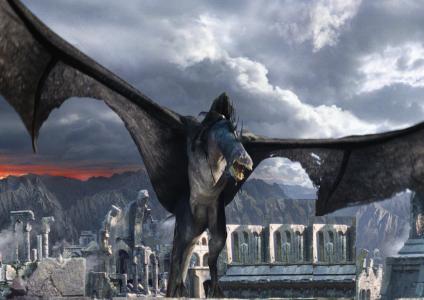 Winged
steeds of the Nazgul. The Fell Beasts were huge,
larger than any bird, and their wingspans were great. Their wings were
made of hide stretched between bones like horned fingers and they had no
feathers. They had beaks and long necks. The Fell Beasts smelled foul and
they shrieked.
Winged
steeds of the Nazgul. The Fell Beasts were huge,
larger than any bird, and their wingspans were great. Their wings were
made of hide stretched between bones like horned fingers and they had no
feathers. They had beaks and long necks. The Fell Beasts smelled foul and
they shrieked.
The Fell Beasts were similar to but not exactly like the pterodactyl and may have been prehistoric creatures that had somehow survived into the Third Age. They were nutured and fed fell meats by Sauron and became steeds for his most dreadful servants, the Nazgul.
The Fellowship first encountered one of the Fell Beasts on the night of February 23, 3019, as they rowed down the Anduin. They were attacked by Orcs, and then a dark shape passed overhead. Legolas shot and killed the Beast with an arrow, but its Rider survived. Frodo sensed that it was one of the Nazgul.
When Merry and Pippin were captured by Uruk-hai at Amon Hen on February 26, Grishnakh, an Orc of Mordor, said the prisoners should be taken across the Anduin where a winged Nazgul waited. Ugluk taunted Grishnakh about the mount that had been shot out from under the Nazgul, and Grishnakh said that the winged Nazgul were not yet ready to show themselves on the west side of the Anduin. They were to be used for the War and other purposes.
Frodo and Sam heard the cry of a Winged Nazgul over the Emyn Muil on February 29. In the Dead Marshes on the night of March 1-2, Frodo, Sam and Gollum saw a Winged Nazgul fly overhead and then return to Mordor. Gollum was terrified and afterwards Sam sensed a change for the worse in Gollum. They felt another passing overhead at dusk on March 4 and again after midnight on March 5. Later on March 5, Sam saw four more of the Fell Beasts circling.
That same day, across the Anduin, Pippin looked into the palantir while Gandalf slept. Shortly afterwards, a Fell Beast flew over the camp at Dol Baran. Gandalf took Pippin up onto Shadowfax and rode swiftly to Minas Tirith. Gandalf explained that the Fell Beast could not have flown 200 leagues from Mordor in reponse to Pippin's action, and said that the Nazgul had probably been sent earlier to determine what Saruman was doing.
When Gandalf and Pippin stopped at Edoras on March 6, a Fell Beast came once more and descended almost to the roof of Meduseld. Gandalf then counselled the Rohirrim to assemble in the valley at Dunharrow rather than in the fields.
Pippin and Beregond felt a shadow pass across the sun as they stood on the walls of Minas Tirith on March 9. The next day Faramir and his men were returning to Minas Tirith pursued by five Nazgul on Fell Beasts. Gandalf rode out to meet them and sent a shaft of white light from his staff to hit one of the Fell Beasts. The Nazgul flew away and Faramir entered the City.
Faramir was sent out again to defend the river against the enemy, and when he and his men were forced to retreat to the Pelennor on March 13 they were again pursued by Winged Nazgul, but the Nazgul once again fled when Gandalf appeared, for their Captain was not ready to face him.
On March 15, as Frodo and Sam escaped from the Tower of Cirith Ungol, the Watchers at the gate let out a wail, and a Winged Nazgul appeared and landed on the battlements. Frodo and Sam escaped by jumping from a cliff into a thicket.
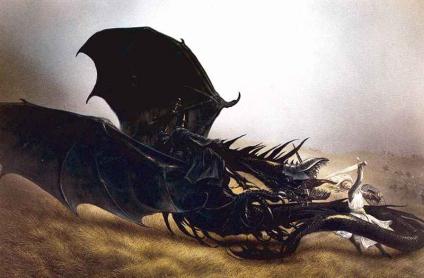 At
the Battle of the Pelennor Fields on
March 15, the Witch-king of Angmar descended
onto the field on a Fell Beast. The horses of the Rohirrim fled in terror.
Merry and Eowyn were thrown from Windfola.
Theoden's
mount Snowmane was pierced by a dart
and fell on his master. The Fell Beast dug its claws into Snowmane's body.
It attacked Eowyn when she confronted the Witch-king, and she beheaded
the Fell Beast. Then she and Merry defeated the Witch-king. After the battle
the carcase of the Beast was burned.
At
the Battle of the Pelennor Fields on
March 15, the Witch-king of Angmar descended
onto the field on a Fell Beast. The horses of the Rohirrim fled in terror.
Merry and Eowyn were thrown from Windfola.
Theoden's
mount Snowmane was pierced by a dart
and fell on his master. The Fell Beast dug its claws into Snowmane's body.
It attacked Eowyn when she confronted the Witch-king, and she beheaded
the Fell Beast. Then she and Merry defeated the Witch-king. After the battle
the carcase of the Beast was burned.
In Mordor, Frodo and Sam saw a Fell Beast flying to Barad-dur. They sensed that something had gone wrong for Sauron, though they could not know of the Witch-king's defeat, and Sam felt a flare of hope.
The remaining Winged Nazgul were sent by Sauron to shadow the approach of the Captains of the West as Frodo and Sam made their way across the plain of Gorgoroth. They circled the battlefield during the Battle of the Morannon on March 25.
When Frodo claimed the Ring, the Winged Nazgul raced toward Mount Doom but they were too late. The Ring was destroyed and the mountain erupted in fire. The Nazgul and their steeds were engulfed in flame.
Names &
Etymology:
The word fell in this sense
means "cruel, terrible."
The Fell Beasts and their riders were also called the Black Wings, the Winged Messenger, Winged Nazgul, winged steeds, Wraiths on wings, Fell Riders of the air, Black Riders of the air.
Sources:
The Fellowship
of the Ring: "The Great River," p. 403-404
The Two
Towers: "The Uruk-hai," p. 49, 55; "The White Rider," p. 101; "The
Palantir," p. 201, 204-5; "The Passage of the Marshes," p. 237-38, 242-43;
"The Black Gate Is Closed," p. 253
The Return
of the King: "Minas Tirith," p. 19, 38; "The Muster of Rohan," p. 66;
"The Siege of Gondor," p. 82-83, 89, 93-94; "The Battle of the Pelennor
Fields," p. 115-17, 120; "The Black Gate Opens," p. 168; "The Tower of
Cirith Ungol," p. 192; "The Land of Shadow," p. 193-94, 196; "Mount Doom,"
p. 215, 223, 224; "The Field of Cormallen," p. 226
Letters
of J.R.R. Tolkien: Letter #211
Descendants of Shelob. The Great Spiders of Mirkwood were not as powerful as Shelob, but they were still large and terrible creatures. Shelob had numerous spawn, and her mates included her own offspring.
Some of Shelob's offspring migrated from the Mountains of Shadow on the border of Mordor to Mirkwood. Evil creatures began to populate the forest after Sauron came to live there at Dol Guldur around the year 1050 of the Third Age.
The Great Spiders of Mirkwood had a colony in the northern part of the forest, as well as around Dol Guldur in the south. They lived on networks of webs which they wove among the trees. The Great Spiders also used their webs to trap their prey and dangle their victims from tree branches after stunning them with poison. The Elves of the Woodland Realm showed the Great Spiders no mercy, but they could not exterminate them.
In 2941, Great Spiders captured Fili, Kili, Balin, Dwalin, Bifur, Bofur, Bombur, Oin, Gloin, Dori, Nori, and Ori, who were passing through Mirkwood on the way to the Lonely Mountain. One Spider tried to capture their companion Bilbo Baggins but the Hobbit managed to escape. Bilbo killed the Spider with his Elvish sword, which he then named Sting.
With the help of Sting, some well-aimed stones, and a Ring that turned him invisible, Bilbo was able to lure the other Great Spiders away from the Dwarves. Bilbo then cut the Dwarves free of the spiderwebs ensaring them. Hundreds of angry Great Spiders returned and attacked Bilbo and the Dwarves. Again Bilbo lured them away, allowing the Dwarves to escape. The Spiders feared Sting, and eventually they gave up and returned to their colony. Many of the Great Spiders had been killed.
After Sauron was defeated at the end of the Third Age, Dol Guldur was destroyed. The shadow on Mirkwood was lifted and the forest was cleansed of evil. What became of the Great Spiders is not known, but it seems likely that the forest was freed of their evil presence as well.
Names &
Etymology:
Bilbo taunted the Great Spiders
with a number of insulting names.
Attercop is from the Old English
attorcoppe
meaning "spider," where attor means "poison" and
coppe may
mean "head." A tomnoddy is a foolish or stupid person. Cob
is from coppe, short for
attorcoppe meaning "spider," also
found in the word cobweb. Lob is from lobbe, another
Old English word for "spider."
Sources:
The Hobbit:
"Flies and Spiders," p. 151-52, 166-76, 180; "Barrels out of Bond," p.
185
The Two
Towers: "Shelob's Lair," p. 332
The Annotated
Hobbit, edited by Douglas A. Anderson: "Flies and Spiders," p. 211-12
notes 14, 15, and 16
Shelob |
Frodo
flees Shelob in the New Line film
|
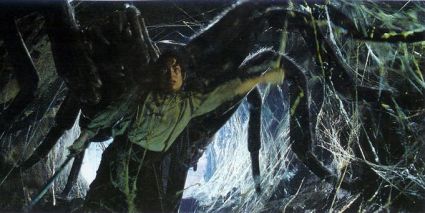 Evil
entity in spider form. Shelob's body was vast and bloated and her wrinkled
hide was thick and tough with no weak spots. Her upper body was black with
markings and her belly was a luminous white and gave off a terrible stench.
Evil
entity in spider form. Shelob's body was vast and bloated and her wrinkled
hide was thick and tough with no weak spots. Her upper body was black with
markings and her belly was a luminous white and gave off a terrible stench.
Shelob's legs had knobbed joints that bent above her back. Each leg was covered with stiff hairs and ended in a claw. Her neck was a short stalk and on her head were great horns and two clusters of multi-faceted eyes. She secreted venom through a beak around her mouth.
Shelob was a creature of great malice whose only thought was to devour and destroy.
Little she knew of or cared for towers, or rings, or anything devised by mind or hand, who only desired death for all others, mind and body, and for herself a glut of life, alone, swollen till the mountains could no longer hold her up and the darkness could not contain her.Shelob was the offspring of Ungoliant. In ancient times, Ungoliant helped Morgoth destroy the Two Trees of Valinor and she then went to Middle-earth where she spawned numerous Great Spiders that lived in the Mountains of Terror in Beleriand. At the end of the Third Age, Shelob was the only one of Ungoliant's offspring left in the world.
The Two Towers: "Shelob's Lair," p. 333
Shelob had numerous offspring herself, including the Great Spiders of Mirkwood. They were lesser creatures than herself though still terrible. Shelob sometimes mated with her own offspring, and afterwards she devoured them.
It is not known how Shelob came to the southeast of Middle-earth. Sometime before the year 1000 of the Second Age, she made her lair on the western border of Mordor in the Mountains of Shadow high in the pass that came to be called Cirith Ungol. Shelob's Lair was called Torech Ungol. It was a long tunnel with many branches and secret exits. Inside it was pitch dark and there was an unbearable stench.
At first, Shelob fed on Men and Elves who ventured near her lair. As Sauron's power increased and Minas Ithil became the Dead City of Minas Morgul, her diet consisted mainly of Orcs. She stung her victims in the neck, injecting them with a poison that made them unconscious and limp, and she wrapped them in her silken webs and hung them in her lair. Then she drank their warm blood and feasted on their living flesh.
Sauron was aware that Shelob lived in Cirith Ungol on the borders of his realm. Her presence guarded the pass more effectively than any garrison, though Shelob served only herself and was not allied with Sauron. The Dark Lord sometimes sent prisoners that he had no further use for into her lair to provide her with sport and food.
In 2980 of the Third Age, Shelob encountered Gollum, a scrawny, unappetizing creature who grovelled before her. Many years later, on March 11, 3019, Gollum returned to Shelob's Lair and promised to bring her sweet meat. The next day, Frodo Baggins and Sam Gamgee entered her lair. Shelob tracked them through the tunnels and was about to attack them when Frodo brought out the Phial of Galadriel and cried, "Aiya Eärendil Elenion Ancalima!" ("Behold, Earendil, brightest of the stars!" - TTT, p. 329)
Shelob was not daunted at first, for she had heard that cry from the Elves long ago. But then Frodo turned and advanced on her with his sword Sting in one hand and in the other was the Phial blazing brighter than anything she had ever seen. Shelob felt the first stirrings of doubt and she retreated.
Shelob did not give up, however. As the Hobbits escaped from her lair on March 13, Shelob emerged from one of her secret exits. She descended swiftly on Frodo and stung him in the neck and wrapped his body from shoulder to ankle in her web. Before she could make off with her prey, she was attacked by an adversary more furious and determined than any she had ever encountered.
It was Sam Gamgee, who rushed to Frodo's defense and hewed off one of Shelob's claws and put out one of her eyes before she could react. He then sliced her underbelly, but though poison bubbled from the gash it was not enough to pierce her thick hide. Shelob raised her huge belly and then bore down, intending to crush Sam beneath her. But Sam held Sting aloft, and Shelob skewered herself on the blade. She shuddered and convulsed in anguish and was prepared to attack again when Sam brought out the Phial and invoked the name Elbereth, one of the Valar.
| "A Elbereth Gilthoniel
o menel palan-diriel, le nallon sí di'nguruthos! A tiro nin, Fanuilos!" TTT, p. 339 |
"O Elbereth Starkindler
from heaven gazing far, to thee I cry now beneath the shadow of death. O look towards me, Everwhite." Ardalambion |
Sam's indomitable spirit caused the Phial to kindle with a brilliant white light. The pain was intolerable to Shelob; her vision was seared and her mind was in agony. She crawled back into her lair oozing a trail of green-yellow slime. Shelob's ultimate fate is not known. She may have died from the wounds inflicted by Sam, or she may have spent long years in pain and misery healing herself until she was strong enough to wreak terror once more.
Frodo survived but he never fully recovered from Shelob's sting. He became ill on the anniversary of the attack each year for as long he remained in Middle-earth.
Names &
Etymology:
The name Shelob means "female
spider." The word lob is an archaic English term meaning "spider"
derived from the Old English lobbe. The Elvish Ungol means
"spider" derived from ungo meaning "cloud, dark shadow."
Also called Shelob the Great. Shagrat referred to Shelob as Her Ladyship. Sauron called Shelob his cat. Gollum referred to Shelob simply as She or Her.
Sources:
The Two
Towers: "Shelob's Lair," passim; "The Choices of Master Samwise," 337-39,
346-50
The History
of Middle-earth, vol. V, The Lost Road and Other Writings: "The Etymologies,"
entry for UNG
The Letters
of J.R.R. Tolkien: Letter #144
TrollsLarge creatures of great strength frequently in the service of the Enemy. Trolls were humanoid in shape but monstrous in appearance. They were much taller and broader than Men. They had scaly skin and large flat feet with no toes, and their blood was black.Trolls were generally rather stupid. They did not build or create anything. Trolls hoarded riches that they stole, and they often ate the people they robbed. Trolls had no language of their own, though some Stone-trolls in Eriador were able to speak the Common Speech and Sauron taught Trolls in his service the Black Speech. Trolls were incredibly strong and powerful and difficult to kill. Their main weakness was that most Trolls turned to stone when exposed to sunlight. Trolls dwelled in Mordor, southern Mirkwood, the Misty Mountains including Moria, and in the Ettenmoors in Eriador near the woods called the Trollshaws. Trolls lived in a variety of habitats. There were Cave-trolls, Hill-trolls, and Mountain-trolls. There may even have been Snow-trolls: Helm Hammerhand was compared to one, though no other record of such a creature exists. Stone-trolls may have been a specific breed of Troll, or this may have been a general term that applied to all Trolls that turned to stone in sunlight. Trolls may in fact have been made from stone originally. It is said that Trolls were made by Morgoth, possibly in mockery of the Ents. Tolkien was uncertain of their origin: "I am not sure about Trolls. I think they are mere 'counterfeits', and hence ... they return to mere stone images when not in the dark. But there are other sorts of Trolls beside these rather ridiculous, if brutal, Stone-trolls, for which other origins are suggested."By "other sorts of Trolls," Tolkien apparently meant the Olog-hai, a superior breed of Troll created by Sauron at the end of the Third Age. It is not known what method or stock Sauron used to breed this new kind of Troll. In an unpublished note, in what appears to be a reference to the Olog-hai, Tolkien suggested that "It would seem evident that they were corruptions of primitive human types." (HoME X, p. 414) The Olog-hai could withstand direct sunlight and they were more cunning than other Trolls. They were large and powerful and their skins were as hard as stone. They understood the Black Speech, though they rarely spoke. They lived near Sauron's stronghold of Dol Guldur in southern Mirkwood and in the mountains of Mordor. The Olog-hai were entirely under Sauron's command and acted solely in his service. As Sauron's power grew, Trolls became more of a menace in Middle-earth. Aragorn's grandfather Arador was killed by Hill-trolls in the Ettenmoors in 2930 of the Third Age. On his adventure in 2941, Bilbo Baggins met three Trolls named Tom, Bert, and William Huggins. These Stone-trolls roamed the Trollshaws and they had a cave there where they kept the riches they acquired, including Glamdring, Orcrist, and Sting. It is not known where or from whom the Trolls obtained these swords. Tom, Bert, and William spoke the Common Speech, though rather poorly. They ate mutton and passing travellers when they could get them. They were pleased to capture Bilbo and the thirteen Dwarves, but Gandalf tricked them into arguing over how to cook them until the sun rose and the three Trolls turned to stone. They remained there like statues; Frodo Baggins and his companions saw them 77 years later while travelling to Rivendell. The Fellowship encountered live Trolls several times during their quest as well. In Moria, they were attacked by a Cave-troll, which Frodo stabbed in the foot. Mountain-trolls wielded the great battering ram Grond at the Battle of the Pelennor Fields and destroyed the gates of Minas Tirith. A great company of Hill-trolls from Gorgoroth fought at the Battle of the Morannon. Since the battle took place during the day, these Hill-trolls may have been of the Olog-hai strain. The Hill-trolls struck down many Men of Gondor with their heavy hammers. The Troll-chief wounded Beregond and would have bitten his throat, but Pippin Took stabbed the Troll with his sword, which he later called "Troll's bane." After the battle, Gimli found Pippin alive under the Troll's heavy carcass. After Sauron's downfall, the Trolls in his service became mindless and directionless without his evil will to guide them. Some slew themselves and others fled and hid. At the beginning of the Fourth Age, the Men of Gondor and Rohan continued to hunt down Sauron's servants, and it is likely that in time Trolls ceased to pose a threat to the peoples of Middle-earth. Names &
Etymology:
The Black Speech word was Olog. The ending hai appears to be a collective plural also found in Uruk-hai. Sources:
|
Trolls
in the New Line film
A Stone-troll turned to stone 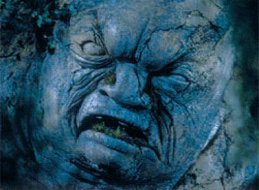
A
Cave-troll
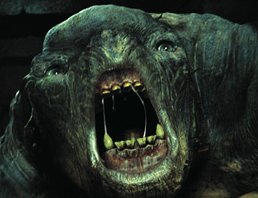
A
Hill-troll
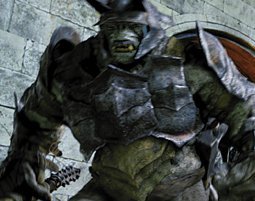
Olog-hai
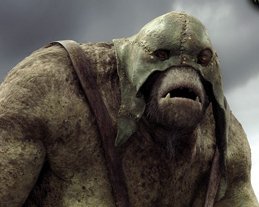 |
Watcher in the Water |
Watcher
in the Water in the New Line film
|
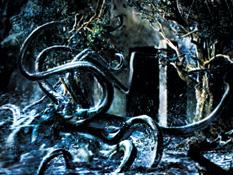 Water-dwelling
creature outside Moria. The Watcher in the Water
had tentacles that were pale green and luminous and had gripping fingers
at the ends. The Watcher's nature and origin are uncertain. Gandalf
suggested that it may have come from the waters under the Misty
Mountains. The Watcher lived outside the West-gate
of Moria in a lake that had been formed by the damming of Sirannon,
the Gate-stream.
Water-dwelling
creature outside Moria. The Watcher in the Water
had tentacles that were pale green and luminous and had gripping fingers
at the ends. The Watcher's nature and origin are uncertain. Gandalf
suggested that it may have come from the waters under the Misty
Mountains. The Watcher lived outside the West-gate
of Moria in a lake that had been formed by the damming of Sirannon,
the Gate-stream.
In 2994 of the Third Age, the fifth year of the colony established by Balin in Moria, the Watcher in the Water killed Oin, who had been one of Bilbo Baggins' companions on the quest to the Lonely Mountain.
The Fellowship arrived at the West-gate of Moria on January 13, 3019, and discovered the lake that had been formed from the Sirannon. Frodo shuddered with disgust when his foot touched the water, and ripples began to form on the surface of the lake. Boromir threw a stone into the water and more ripples appeared, reaching the shore where the Fellowship stood.
"Why did you do that, Boromir?" said Frodo. "I hate this place, too, and I am afraid. I don't know of what: not of wolves, or the dark behind the doors, but of something else. I am afraid of the pool. Don't disturb it!"Just as the Fellowship was entering the gate, the Watcher grabbed Frodo's foot with one of its tentacles. Sam slashed at the tentacle with his sword and Frodo escaped, but 20 more tentacles came out of the water. The Fellowship fled into Moria and the Watcher slammed the doors shut behind them and blocked the gate from the outside. Bill the Pony was able to escape the Watcher and made his way back to Bree.
The Fellowship of the Ring: "A Journey in the Dark," p. 321
It is not known whether the Watcher acted independently in attacking the Fellowship or whether it was under some external influence, but Gandalf found it disturbing that the Watcher singled out the Ring-bearer.
The ultimate fate of the Watcher in the Water is unknown.
Sources:
The Fellowship
of the Ring: "A Journey in the Dark," p. 314-23
All entries are Copyright © by the Thain from former tuckborough.net. Please contact me if you are Thain or know anything about how to contact the original author.
2003-2011, The Thain's Book - thainsbook.minastirith.cz
- e-mail: thain at tuckborough.net